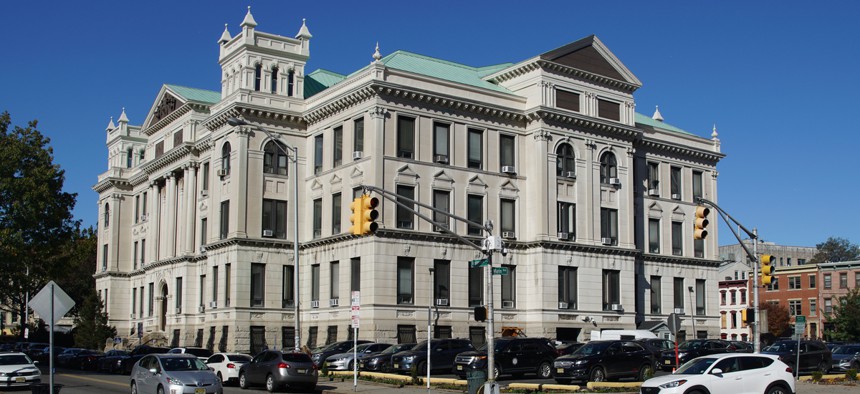The Troubling Decline in City Revenue Growth

City hall in Jersey City, New Jersey. Shutterstock/Mariusz Lopusiewicz

Connecting state and local government leaders
COMMENTARY | The economy continues to grow, yet cities anticipate revenue problems. How can both be true?
The most startling conclusion of The National League of Cities’ new fiscal conditions report was that revenue growth “stalled” last year and that this trend has continued—creating real problems for city budgets.
This came as a particular shock to us because gross domestic product from coast to coast continues to grow. According to the U.S. Bureau of Economic Analysis, “Real gross domestic product (GDP) increased in all fifty states in the first quarter of 2019.”
So, the question emerges: While the economy has remained healthy, why are so many cities experiencing revenue growth stagnation or even declines? Columbia, Missouri (population 122,000), for example, saw annual growth in sales tax revenues of 5.8 percent in 2011, but just 1 percent growth in 2018. The city’s budget report last year noted, “Sales tax growth has been historically low for the last four years. These revenue challenges appear to be long term problems.”
Other cities have actually seen sales tax revenues decrease, according to the most recent available data. Minneapolis, for example, experienced a 9.6 percent drop in fiscal year 2018, while Overland Park, Kansas received 6 percent less in sales tax receipts—which provide nearly half of city revenues—between 2018 and 2019.
While property taxes, typically the major source of city revenues, have largely stayed stable, there are plenty of other reasons why revenues are suffering.
Michael Pagano, co-author of the NLC report, is also dean of the University of Illinois (Chicago) College of Urban Planning and Public Affairs and executive director of the Government Finance Research Center there. He was particularly surprised by the report’s conclusions, expecting that a growing economy should correlate neatly with higher revenues.
The flaw he discovered, however, turned out to emanate from a long-discussed phenomenon. City sales taxes, starting as far back as 1955, have suffered because people don’t just buy durable goods, but spend money on services. Many services, including doctor and attorney fees, are not subject to sales taxes. “There is a misalignment between the economy and tax structures,” says co-author Christiana McFarland, research director of the National League of Cities.
Another reason that gross domestic product growth hasn’t translated into new revenues has been that people are putting ever more money into savings, as opposed to spending it on taxable items. According to the Bureau of Economic Analysis, while people were saving just 3 percent of income in 2017, the latest data shows that savings are closer to 7 percent now. This means that money that might have been spent on bigger homes, which generate more property taxes, or on new cars or boats that bring in big sales taxes, is being saved instead.
One of the biggest sources of other revenues for many cities is state aid. However, at a time when some states struggle to keep their own budgets balanced, one of the easiest ways to accomplish this is to cut back on aid to cities and their schools. Last year, Newark, New Jersey lost $7 million in state aid intended to pay for school repairs and charter schools. As of last April, the Jersey City School System, according to Politico, “has filed a lawsuit against the state to stop $180 million in anticipated funding cuts over the next several years.”
Sometimes, the mere threat of a revenue decline can be a problem unto itself. Small town Durham, Connecticut is short $275,000 in state aid, while the state government wrangles over passing a $1 billion bond issue. It’s expected that the town will eventually get the cash, but the waiting period can wreak havoc on planning. Over the last several years, municipalities in Connecticut have had to approve budgets and set mill rates before the state passed a budget, often using worst case scenarios for projected state revenue projections. This results in deferred projects and maintenance, as well as increases in taxes.
Meanwhile, tariff wars haven’t helped. This is particularly true for cities dependent on either manufacturing or agriculture, and as a result has been especially problematic for the Midwest where overall cities’ sales taxes dipped about two percent in constant dollars between fiscal year 2018 and 2019, estimates Pagano.
Then there’s the aging of the population. As cities see their median ages rise, they are increasingly serving a population less likely to be making purchases that bring in sales taxes. Moreover, for the portion of cities that collect income taxes, men and women on fixed incomes are simply not big revenue producers.
Even as all these factors help explain the NLC’s findings, another factor at play is called “crowding out,” and refers to the dramatic increase in the amount cities are now putting into their pension plans, just to keep their funds from disintegrating. For example, Lexington, Kentucky’s revenue stream has been growing at a slower rate than in the past. That would be more easily sustainable were it not for a $3.3 million increase in the amount it now is putting into its pension plans.
All of the factors that contribute to the stagnation or decline in revenues are even more threatening now than they would be at other times in the economic cycle. With these trends unlikely to abate anytime soon, the inevitable arrival of a recession is just going to make things worse.
[Disclosure: The authors are senior advisers for the Government Finance Research Center, which was cited in this piece.]
Katherine Barrett and Richard Greene of Barrett and Greene, Inc. are columnists and senior advisers to Route Fifty.

NEXT STORY: With Overall State Spending Up, Transportation Sees Notable Gains





